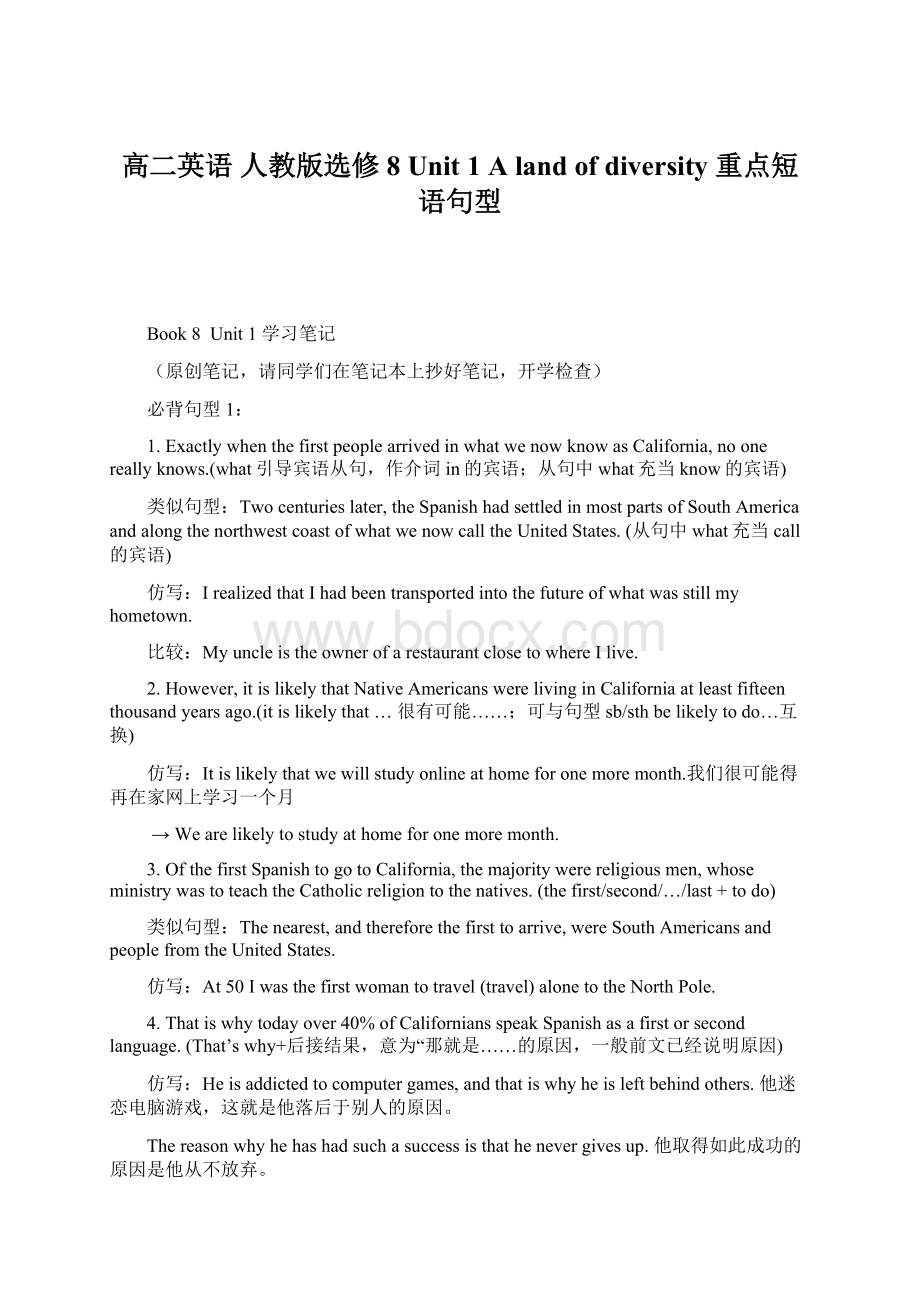高二英语 人教版选修8 Unit 1 A land of diversity 重点短语句型Word格式文档下载.docx
《高二英语 人教版选修8 Unit 1 A land of diversity 重点短语句型Word格式文档下载.docx》由会员分享,可在线阅读,更多相关《高二英语 人教版选修8 Unit 1 A land of diversity 重点短语句型Word格式文档下载.docx(12页珍藏版)》请在冰豆网上搜索。

5.ItwasthebuildingoftherailnetworkfromthewesttotheeastcoastthatbroughtevenlargernumberstoCaliforniainthe1860s.(强调句型)
Itistheabilitytodothejobthatmatters(重要),notwhereyoucomefromorwhatyouare.是你做事的能力才重要,而不是你的来历或身份。
6.Itisbelievedthatbeforelongthemixofnationalitieswillbesogreatthattherewillbenodistinctmajorracialorculturalgroups,butsimplyamixtureofmanyracesandcultures.(Itisbelieved/reported/thought/supposed…that…人们……;
据……)
Itisbelievedthatgreenhousegasesarethemaincausesofglobalwarming.人们认为温室气体是全球变暖的主要原因。
必背短语1:
1.compare…with/to…把…和…相比较
2.liveon继续存在;
继续生存;
以……为食;
靠……生活
Thedoctorspassedawaybuttheirspiritswillliveonforever.这些医生们走了,但他们的精神将永存。
Thepoordisabledcoupleliveonasmallincome.这对可怜的残疾夫妇靠微薄的收入生活。
近义词:
feedon以……为食
3.bymeansof用……办法,借助
bythismeans用这种方式/法
byallmeans无论如何;
当然可以(口语)
bynomeans决不;
无论如何都不(放句首时句子要倒装)
4.inaddition此外;
而且→additionally;
besides;
furthermore;
moreover
inadditionto除……之外,加之
5.fightagainst与……作斗争
fightwith与……作斗争;
与……并肩作战
fightfor为……而战斗
6.settledin安顿下来;
适应
7.themajority(of…)大多数(接可数或不可数名词,作主语时谓语与后面的名词保持一致)
Themajorityofworkhas(have)beenfinishedbeforedark.天黑之前大部分工作已经被完成了。
inthemajority占大多数
8.declarewaron/against对……宣战
9.makealife习惯于新的生活方式、工作等;
谋生
make/earna/one’sliving谋生
10.electvt.选择;
决定做某事;
选举某人→electionn.选举;
当选
elect…as…选举某人为……electtodo选择做……
DonaldJ.Trumpwaselectedasthe45thpresidentoftheUSin2016.特朗普于2016年当选为美国第45任总统。
11.alargepercentage(of…)大多数的;
大量的
12.keepup坚持;
维持;
保持;
(使)继续;
沿袭(风俗、传统等)
keepupwith跟上
13.become/behometo是……的所在地;
是……的家;
是……的根据地
课文词块翻译1:
1.thethirdlargeststate第三大州
2.intheearly16thcentury在16世纪初期
inthelate19thcentury在20世纪末期
inthe1860s在19世纪60年代
3.atthebeginningofthe20thcentury在20世纪初期
4.allovertheworld全世界
5.achieve/realizeone’sdream实现……的梦想
必背句型2:
1.Itoccurredtosbthat…某人突然想起…
Ithit/strucksbthat…某人突然想起…
Itoccurredtomethathemightbeinterestedintheproblemwehaddiscussed.
我突然想到他可能会对我们讨论的问题感兴趣。
2.Builtin1873,thecablecarsystemwasinventedbyAndrewHallidie,whowantedtofindabetterformoftransportthanhorsedrawntrams.(Builtin1873过去分词短语作状语;
who引导非限制性定语从句)
Borninapoorfamily,Nadiahadonlytwoyearsofschooling.
由于出生于贫寒家庭,Nadia只上过两年学。
3.Ithasblueandwhitesignswithseagullsonthemtoshowthewaytogo.(with复合结构:
with+宾语+宾语补足语,在句中作定语)
Shesawasmallriverwithgreengrassandredflowersonbothsides.
她看到一条小河,两岸长满了红花绿草。
必背短语2:
1.backtoback背靠背
neckandneck肩并肩handinhand手拉手
2.makecomments/acomment(on)评论…;
评价…
3.feellike(doing)想要(做…)
4.teamupwith与……合作或一起工作
comeupwith提出(建议、想法等)catchupwith追上,赶上
putupwith忍受;
容忍keepupwith跟上,赶上
5.markout划线;
标出…界线
bemarkedwith...标记着,以……形式纪念
Whendoingmyreading,IoftenmarkoutwhatIregardasimportantinabook.
6.takein包括;
吸收;
领会,理解;
欺骗;
留宿,收留
7.anumberof若干;
许多(后接可数名词复数)
anincreasingnumberof/agrowingnumberof越来越多的(后接可数名词复数)
8.agreat/goodmany=many;
alarge/greatnumberof许多;
大量(后接可数名词复数)
Agoodmanyteenagersareaddictedtocomputergames.许多青少年沉迷于电脑游戏。
Agreatmanyofthestudentsinourclasshavealreadyreadthebook.我们班许多学生看过这本书。
9.allsortsof各种各样的→allkindsof
avarietyof/varietiesof
10.applyfor申请
11.ratherthan而不是
课文词块翻译2:
1.haveagoodviewof欣赏
2.thecivilauthorities民政局
3.grasptheopportunityof(doing)sth抓住(做)…的机会
简易语法归纳:
复习名词性从句1
一、名词性从句的概念
名词性从句的作用:
在主句中起名词的作用,相当于一个名词,在主句中充当主语、宾语、表语和同位语。
名词性从句的种类:
根据其在主句中所起的作用,分为四类:
主语从句、宾语从句、表语从句和同位语从句。
名从的常见引导词:
从属连词、连接代词和连接副词
1.that/whether/if(从属连词,在从句中不充当句子成分,that无意义,whether/if意为“是否”);
2.what/which/whose/who/whom/whatever/whichever/whosever/whoever/whomever(连接代词,从句中充当主语、表语、宾语和定语)
3.when/where/how/why/whenever/wherever/however(连接副词,从句中充当状语)
二、名词性从句的判定:
一般根据从句的作用和位置来判断
(一)主语从句:
主语一般位于谓语之前,因此主语从句一般位于句首,谓语动词之前;
若有形式主语it,则位于句末
Whenwewillreturntoschoolisnotknownyet.
Itisnotknownyetwhenwewillreturntoschool.
(二)宾语从句:
宾语一般位于及物动词或介词之后,因此宾语从句一般位于及物动词或介词之后;
若有形式宾语it,则位于句末。
WeappreciatewhattherescuemedicalteamofShandonghasdoneforus.
我们很感激山东医援队为我们所做的一切。
Dr.ZhongmadeitclearonJanuary23thatcovid-19canspreadfrompersontoperson.
1月23日钟院士明确提出新冠病毒会人传人。
Ihateitwhenadriverusesahighbeam(远光灯)inthestreetintheevening.
我讨厌司机晚上在街上开远光灯。
(三)表语从句:
表语一般位于连系动词之后,因此表语从句一般位于连系动词之后,尤其是be动词之后(上例5)。
Theboystillremainedwherehegotoffthebustwohoursago.
那男孩仍然呆他在两小时前下车的地方。
(四)同位语从句:
同位语一般位于名词之后,用以解释或补充说明前面名词,因此同位语从句一般位于名词之后,主要是抽象名词之后,用以解释前面抽象名词的具体内容。
Thedreamthatshewillbeasuperstaronedayhasbeeninspiringhertheseyears.
将来会成为超级明星的梦想这些年来一直激励着她。
三、名词性从句的本质:
用一个句子代替一个名词,表示一件事
Iknowasecret.(名词)
Iknowthatheoftenplaysgamesduringthestudytime.(从句)(宾语从句)
Thatheoftenplaysgamesduringthestudytimeistrue.(主语从句)
Thesecretisthatheoftenplaysgamesduringthestudytime.(表语从句)
Thesecretthatheoftenplaysgamesduringthestudytimeistrue.(同位语从句)
三、名词性从句的常见考点:
(一)名词性从句的语序:
引导词+陈述语序
1.Noonecanbesurewhatmanwilllooklikeinamillionyears.
2.Youcan’timaginehowexcitedtheywerewhentheyreceivedtheseniceChristmaspresents.
(二)名词性从句的时态:
1.Hesaidthathewould(will)gotothestation.
2.Ourphysicsteacheroncetoldusthatlighttravels(travel)fasterthansound.
3.TomsaysthatMarywent(go)abroadlastyearandhasbeen(be)therefornearly5months.
主句的动词用过去时,从句谓语动词用过去的某种时态;
主句的动词用过去时,从句表示客观事实,格言,谚语等,从句谓语动词用一般现在时;
主句的动词用一般现在时,从句谓语可根据需要选用各种时态。
(三)名词性从句的主谓一致问题:
Whenwewillreturntoschoolhas(have)notbeendecidedyet.
Whenwewillreturntoschoolandhowwewillreturntoschoolhave(have)notbeendecidedyet.
Whenandhowwewillreturntoschoolhas(have)notbeendecidedyet.
Whatthepoorchildrenneedare(be)books.
Whatthehomelesschildrenneedis(be)love.
单个的主语从句作主语时,谓语动词一般用单数形式。
如果是两个或两个以上的主语从句作主语,谓语动词则用复数形式。
由两个或多个连词引导一个主语从句,谓语动词一般用单数形式。
what引导主语从句时,谓语动词的数由从句的意义决定。
(四)名词性从句引导词的选择:
1.名词性从句指确定的事时,一般用that,无意义,不翻译
Ihadhoped(that)you’dseemyfaceandthatyou’dberemindedthatformeitisn’tover.
2.名词性从句指不确定的事时,一般用whether/if,意为“是否”“与否”
Itdoesn’tmatterwhetheryouturnrightorleftatthecrossing—bothroadsleadtothepark.
这个十字路口你向左拐或者向右拐都没关系,反正两条路都通向公园。
Sheaskedmewhether/ifIhadreturnedthebookstothelibrary,andIadmittedthatIhadn’t.
她问我是否把书还给图书馆了,我承认我没有。
whether和if的区别:
if:
只能用于动词的宾语从句,且不能后接不定式,不能和or(not)连用,不能用于discuss后。
whether:
不能引导否定句。
3.名词性从句指问题时,一般用连接代词what/which/who/whom或连接副词when/where/how/why等。
Wehaven’tdiscussedyet______wearegoingtoplaceournewfurniture.
A.thatB.whichC.whatD.where
Youaresayingthateveryoneshouldbeequal,andthisis______Idisagree.
A.whyB.whereC.whatD.how
—Whatdidyourparentsthinkaboutyourdecision?
—Theyalwaysletmedo______IthinkIshoulddo.
A.whenB.thatC.howD.what
I’mnotsurewho/whichismorefrightened,meorthefemalegorilla(大猩猩)thatsuddenlyappearsoutofnowhere.
—DoyouknowwhatMissZhu’saddressis?
—ShemayliveatNo.3orNo.4ofXianxingroad.I’mnotsureofwhich.
Amoderncityhasbeensetupinwhatwasawastelandtenyearsago.
Amoderncityhasbeensetupintheplacethat/whichwasawastelandtenyearsago.
【注意】当从句部分缺名词时,用连接代词;
当从句部分不缺名词的时候,用连接副词。
what一般指物,who(m)一般指人,which可指人或物,一般有范围选择。
4.连接代词which/what/whose可充当定语,后接名词,构成复合引导词,一起置于从句最前面。
Canyoutellmewhichcakeyouwant?
你能告诉我你想要哪个蛋糕吗?
Whatrolehewillplayinthefilmhasn’tbeenknown.在这部电影中他将扮演什么角色还不知道。
Idon’tknowwhosedogsheiswalking.我不知道她在遛谁家的狗。
5.how可以在从句中“修饰”形容词或副词,构成复合引导词howold/often/long/soon/much…等,一起置于从句最前面。
Doyouknowhowoldsheis?
你知道她多大吗?
Howlongwewillstayhomeisunknown.我们要在家呆多久还不知道。
6.whoever/whomever/whichever/whatever也可以引导名词性从句,翻译为“...的任何...”,往往可以转换成相应的定语从句(whoever=anyonewho;
whatever=everything/anythingthat)。
Whoeverbreaksthelawwillbepunished.任何犯法的人都要受到惩罚。
→Anyonewhobreaksthelawwillbepu